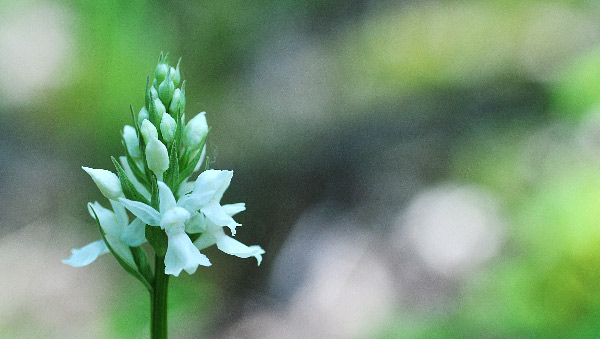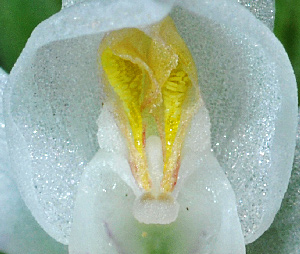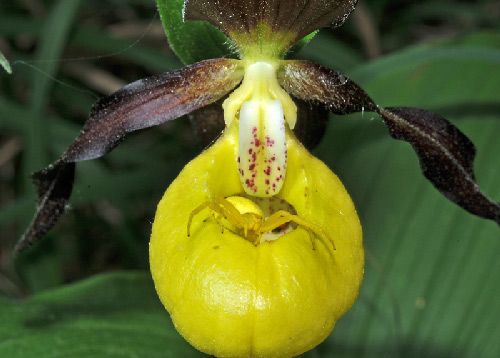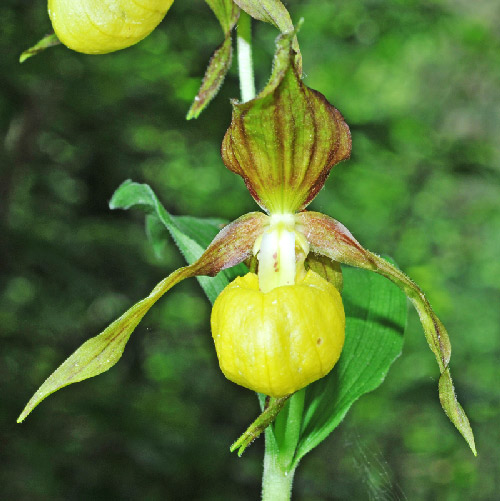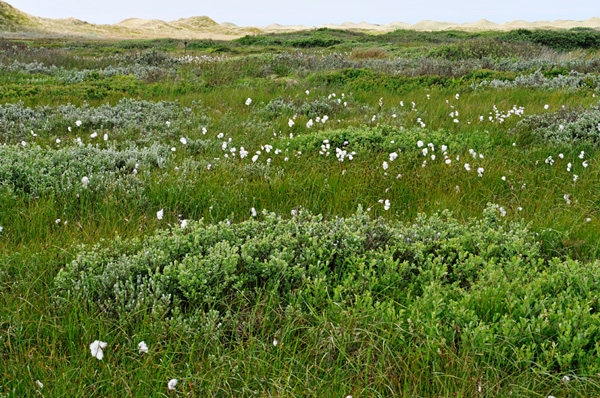
Most orchid species don’t like acid boglands – but there are two rare exceptions: One is geographically widely distributed from Belgium to Northwestern Germany and Scandinavia and is mostly addressed as Dactylorhiza sphagnicola. The other grows only in the Danish region of Thy: Just a few hundred meters behind the coastline of the North Sea there is a population of white-flowered orchids which have been described by Henrik Ærenlund Pedersen as Dactylorhiza majalis subsp. calcifugiens (in: Nordic Journal of Botany, 2004). In 2007, Sebastian Sczepanski and Karel Kreutz argued it would be more appropriate to regard these plants as a subspecies to Dactylorhiza sphagnicola – while Pedersen und Mikael Hedrén are viewing sphagnicola only as another subspecies of Dactylorhiza majalis. Apart from colour, the morphological differences of the single flowers of Dactylorhiza majalis subsp. majalis (left), calcifugiens (middle) and sphagnicola (right) are difficult to discern:
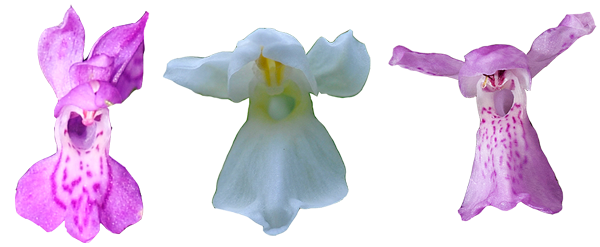 The spur of Dactylorhiza sphagnicola is a bit longer than that of D. majalis subsp. calcifugiens. And the leaves of the latter are spreaded in a broader angle than those of D. sphagnicola:
The spur of Dactylorhiza sphagnicola is a bit longer than that of D. majalis subsp. calcifugiens. And the leaves of the latter are spreaded in a broader angle than those of D. sphagnicola:
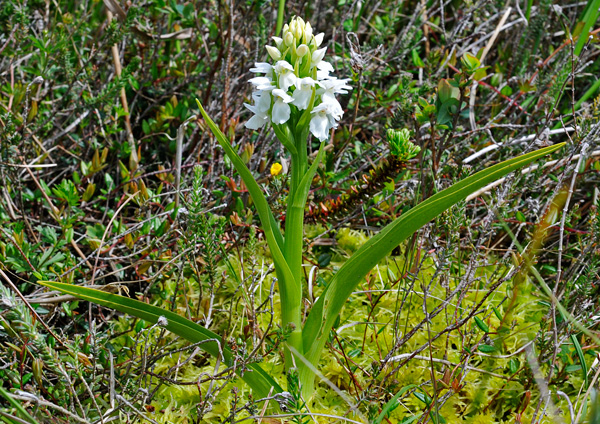
The single flowers don’t show any hue of purple, even the pollinaria lack Anthocyanin. There is rather some yellowish hue in the center of the flower, slightly reminding of Dactylorhiza incarnata subsp. ochroleuca. In contrast to other populations of albiflora forms, e.g. with Dactylorhiza fuchsii, there are no gradual differences in the loss of colour pigments – all the plants are consistent in the white colour of their flowers.
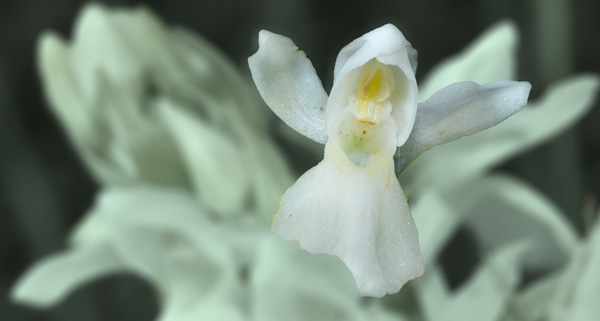
Visiting the region, I found calcifugiens at two places, one near the small fisher village of Lild Strand with only three plants, the other further to the south at a bog called Nissekaer with about 150 plants. Surrounded by dunes this place is a natural depression (danish: “kaer”) with a length of about 1500 and a width of about 250 meters:
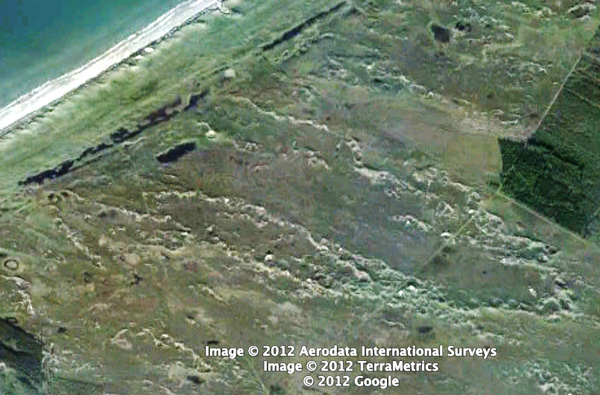
In mid-June the orchids are just in the beginning of flowering. Most Dactylorhiza majalis subsp. calcifugiens are growing at the edges of the wet places, not in the midst of them as it is the case with Dactylorhiza sphagnicola in the Venn moors in Belgium. And the calcifugiens plants are quite smaller, reaching just a height of up to 31 cm. Neighbouring plants are Sphagnum palustre, Equisetum fluviatile; Eriophorum angustifolium, Menyanthes trifoliata, Vaccinium oxycoccus, Calluna vulgaris, Trientalis europaea and even Drosera rotundifolia – most of those plants are clear indicators of acid soil. Among the shrubs there is the dominant Myrica gale, which is used by the brewery of the near-by town Thisted.
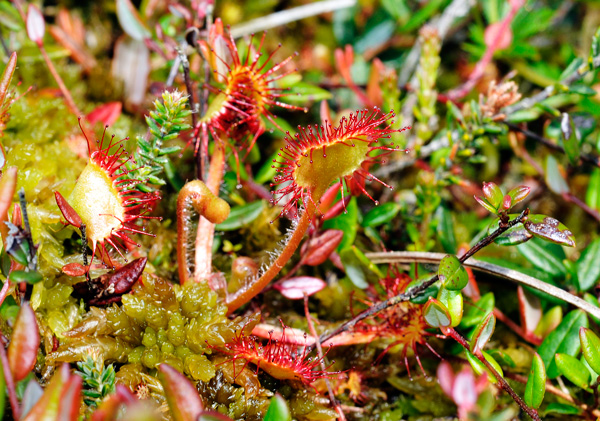
Some calcifugiens plants show a broader labellum, indicating a possible hybrid influence of Dactylorhiza maculata – similar to the sphagnicola plants of the Venn region.
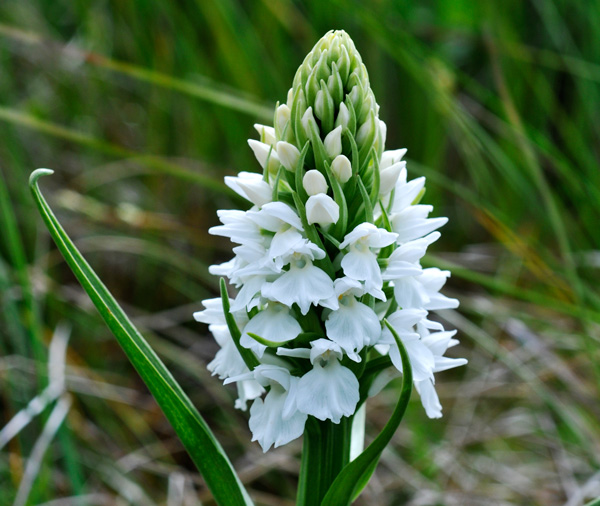
Among all the white-flowered orchids in the Nissekaer bogland I found two purple-flowered plants which might be a hybrid of Dactylorhiza majalis subsp. calcifugiens and Dactylorhiza maculata (left) and a Dactylorhiza maculata still in buds (right):
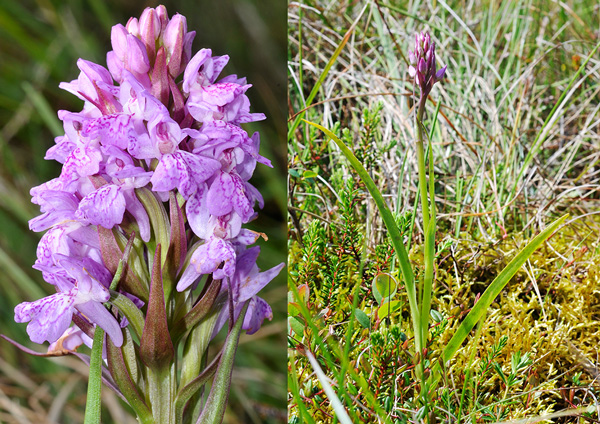
As a visiting and possibly pollinating insect of Dactylorhiza majalis subsp. calcifugiens there was a species of the genus Syrphida – as I’ve seen also with Dactylorhiza sphagnicola in the Venn moor (left)
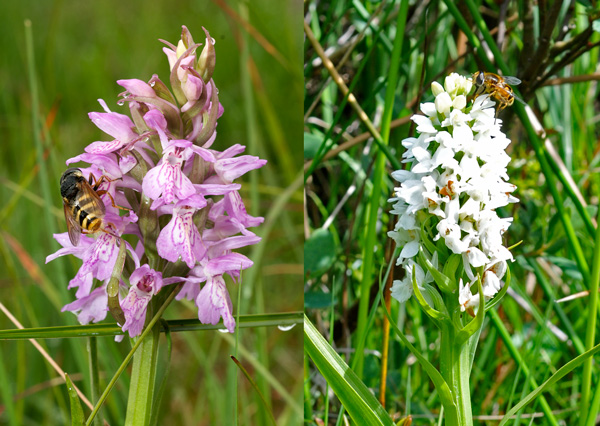
Vividly interacting: Dactylorhiza fuchsii and majalis
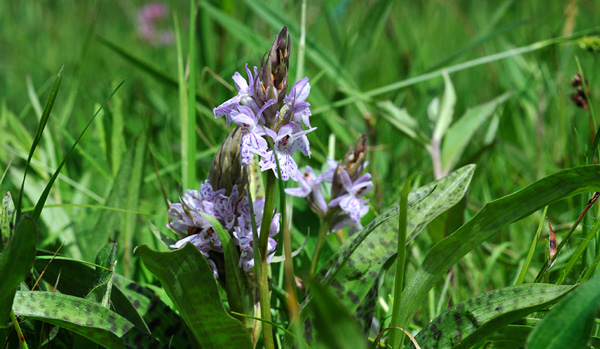 Orchid locations are constantly changing: On a meadow last visited in 2010, the number of Dactylorhiza fuchsii has been quite smaller this year. Now, there have been more Dactylorhiza majalis then before – and several hybrids of both species. These may have quite different forms: either short plants with the broad leaves of majalis (above) and brighter, fuchsii-like flowers with a broad labellum – or more elongated, with narrow leaves and purple flowers with a slightly broader labellum (down).
Orchid locations are constantly changing: On a meadow last visited in 2010, the number of Dactylorhiza fuchsii has been quite smaller this year. Now, there have been more Dactylorhiza majalis then before – and several hybrids of both species. These may have quite different forms: either short plants with the broad leaves of majalis (above) and brighter, fuchsii-like flowers with a broad labellum – or more elongated, with narrow leaves and purple flowers with a slightly broader labellum (down).
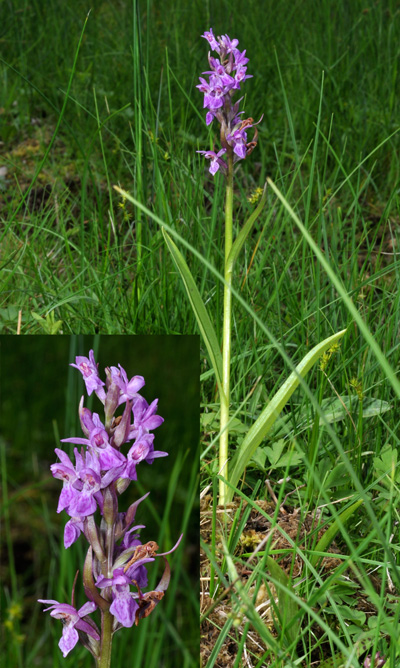 The Dactylorhiza fuchsii on this meadow which has both wet and dry areas are still quite bright, but most retain some purplish hue, at least in the pattern of the labellum. This time, an albiflora form of Dactylorhiza majalis was also flowering.
The Dactylorhiza fuchsii on this meadow which has both wet and dry areas are still quite bright, but most retain some purplish hue, at least in the pattern of the labellum. This time, an albiflora form of Dactylorhiza majalis was also flowering.
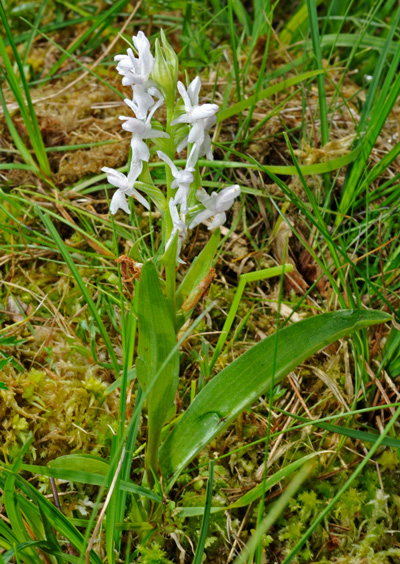

Three albino plants of Cephalanthera damasonium
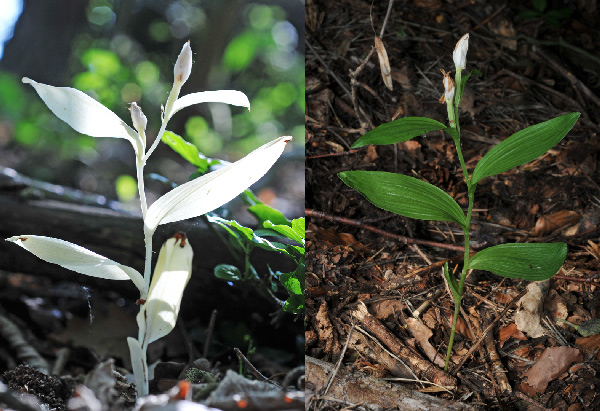 It is well studied that Cephalanthera damasonium belongs to those orchids which can live without chlorophyllum – together with other species of the tribe of Neottieae or the genus Epipactis. While exploring a mixed forest near Lahnstein (Rhineland-Palatinate) together with Ingo Beller of the Arbeitskreis Heimische Orchideen (AHO) Rheinland-Pfalz, we found a group of three albino plants in addition to three green-leafed Cephalanthera damasonium. Of the apochromic plants one has two flowers, one only one flower and one has no flower. Those albino plants receive their organic carbon with the help of fungi. A study of V. Tranchida-Lombardo, M. Roy, E. Bugot, G. Santoro, Ü.Püttsepp, M. Selosse and S. Cozzolino, published in 2010 in Plant Biology suggests that the albino Cephalanthera damasonium may be viewed as “an intermediate step in the evolutionary emergence of mycoheterotrophy”, or of the ability to be nourished both by fungi and photosynthesis. By means of genetic analyses the authors declare: “Albinos could be either permanent mutants, as suggested by phenotype stability over the years, or transitory phenotypic stages, in which genes involved in the photosynthetic pathway can switch off depending on micro-environmental conditions (e.g., the amount of C resources provided by the nearby fungal mycelia or tree roots) that prevent greening.”
It is well studied that Cephalanthera damasonium belongs to those orchids which can live without chlorophyllum – together with other species of the tribe of Neottieae or the genus Epipactis. While exploring a mixed forest near Lahnstein (Rhineland-Palatinate) together with Ingo Beller of the Arbeitskreis Heimische Orchideen (AHO) Rheinland-Pfalz, we found a group of three albino plants in addition to three green-leafed Cephalanthera damasonium. Of the apochromic plants one has two flowers, one only one flower and one has no flower. Those albino plants receive their organic carbon with the help of fungi. A study of V. Tranchida-Lombardo, M. Roy, E. Bugot, G. Santoro, Ü.Püttsepp, M. Selosse and S. Cozzolino, published in 2010 in Plant Biology suggests that the albino Cephalanthera damasonium may be viewed as “an intermediate step in the evolutionary emergence of mycoheterotrophy”, or of the ability to be nourished both by fungi and photosynthesis. By means of genetic analyses the authors declare: “Albinos could be either permanent mutants, as suggested by phenotype stability over the years, or transitory phenotypic stages, in which genes involved in the photosynthetic pathway can switch off depending on micro-environmental conditions (e.g., the amount of C resources provided by the nearby fungal mycelia or tree roots) that prevent greening.”
Mass population of Dactylorhiza fuchsii f. albiflora
In addition to the Irish region of The Burren and the Hesse location of Biebergemuend there is a further location where Dactylorhiza fuchsii tends to white-flowered forms in big numbers: In a birch grove near the village of Wolken in the upper Moselle valley there are several hundred plants with a clear trend to bright and white flowers. A count of a random sample resulted in 13 per cent of white flowers without any markings on the labellum. Further 38 per cent of the plants have a white base colour with pink marks. The differences in flower colours correspond with the results found in the other two regions and are even a little bit more accentuated. These results may give further evidence to the assumption that Dactylorhiza fuchsii is in the midst of an evolutionary process which also changes the phenotype of the species.
Percentages of flower colours in different locations
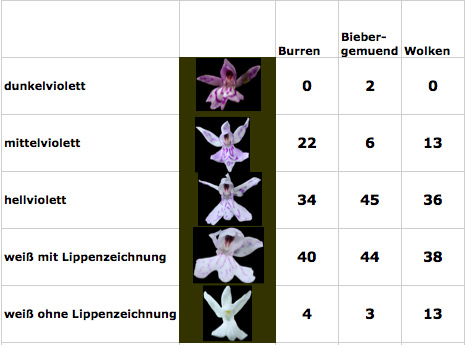
The following tableau shows the wide range of fuchsii flowers found on that location. The brightest forms also lack the Anthocyanine pigments in the pollinaria as the lowest row of examples and the following macro photo demonstrate.
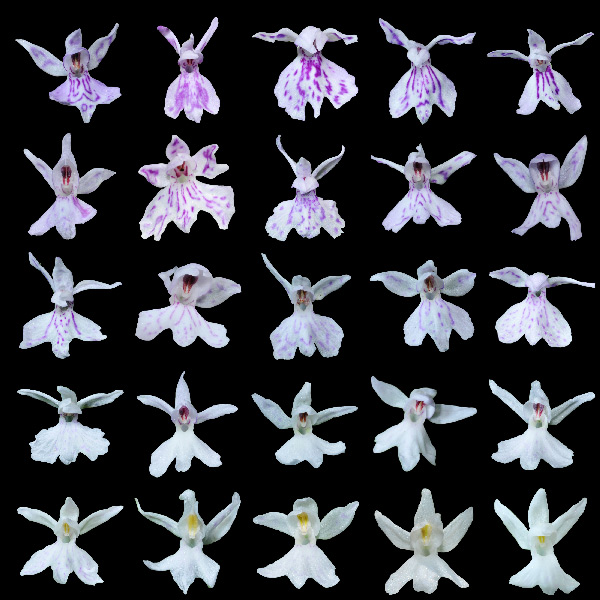
The only other orchids in the forest are Platanthera chlorantha and an Epipactis spec. – while in the other two locations with abundant albiflora forms of Dactylorhiza fuchsii there are also the earlier flowering Orchis mascula (Burren) and Dactylorhiza majalis (Biebergemuend), both flowering in pink and both – as well as Dactylorhiza fuchsii – trying to attract pollinators with nectar deception. Among other plants in the birch forest, a former gravel-pit and now a nature reserve called “Kuhstiebel”, are Orthilia secunda, Fragaria vesca and Tussilago farfara. But the dominating plant there as well as in a nearby marsh area is Dactylorhiza fuchsii with mostly spotted leaves – even in the case of the white-flowered plants: 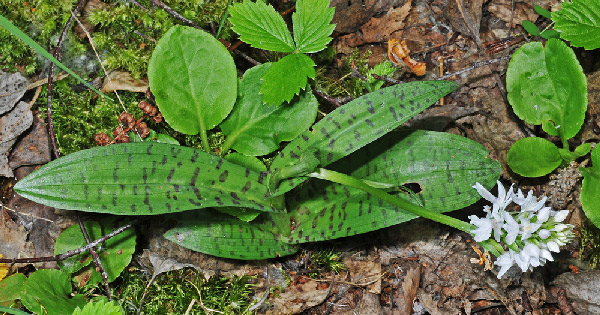
Colour matters – a spider’s relationship with Cypripedium calceolus
Misumena vatia, a crab spider has developed a special relationship with orchids. Sitting on an albiflora form of Dactylorhiza fuchsii it wears its white body, as Norbert Griebl has observed. Now I’ve watched her in Thuringia on Cypripedium calceolus in its yellow form – a perfect mimicry. The spider makes use of the fact that the slipper-shaped pouch of the plant traps small insects in order to ensure its fertilization – while is spider is only interested in food.
The spider changes its colour by secreting a yellow pigment into the outer cell layer of its body.While sitting on white flowers, this pigment is transported into lower layers. The colour change from white to yellow takes between 10 and 25 days, the reverse about six days.
The Cypripedium calceolus in Thuringia show almost none varieties in terms of flower colours. Among more than 1000 plants I’ve found one with reduced anthocyanin pigments in sepals and petals which could be addressed as Cypripedium calceolus forma citrinum.
Dactylorhiza cyrnea – a new species described on Corsica
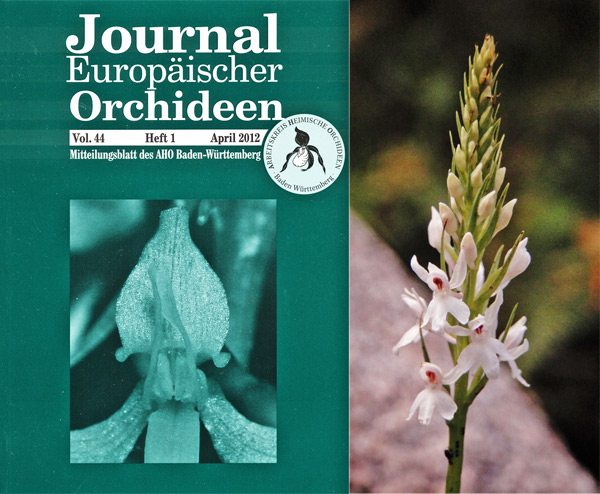
Two specialists of the orchid flora on Corsica, Wolfram Foelsche and Klaus Cord-Landwehr, have described a new Dactylorhiza species: Dactylorhiza cyrnea belongs to the group of Dactylorhiza maculata and shares its characteristics of a tetraploid set of chromosomes. In their article “Dactylorhiza cyrnea und die Taxa der Gattung Dactylorhiza auf Korsika”, published in the Journal Europäischer Orchideen (Vol. 44, Heft 1, April 2012), the authors review the findings of Dactylorhiza insularis, Dactylorhiza sambucina and Dactylorhiza saccifera on Corsica and note that there is no Dactylorhiza majalis confirmed for this Mediterranean island. The plants described as Dactylorhiza cyrnea is morphologically similar to the diploid Dactylorhiza fuchsii. They are rather elongated and grow in humid locations. The leafs are mostly vaguely spotted but may also be unspotted. The flowers have a markedly thin spur (contrasting the thick spur of D. saccifera) which is shorter than the ovary. Their colour is a bright pink, with a purple labellum pattern. The population described by the authors “offers a very consistent appearance” – but there are also white flowered plants occasionally, the authors note. The photo above on the right, generously sent to me by Wolfram Foelsche, is also included in the article.
Lecturing about albiflora orchids in Koblenz
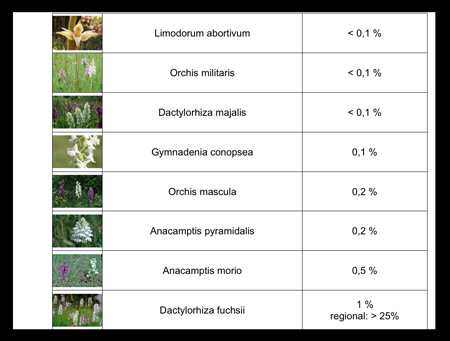
Invited by the Arbeitskreis Heimische Orchideen (AHO) Rhineland-Palatinate I’ve presented some thoughts about albiflora orchids at a meeting in Koblenz. After introducing the basics of the bio-chemistry and genetics of flower colours I pointed to the striking differences in the frequency of albiflora forms with certain orchid species. With frequencies of more than 0.1 per cent one might assume that albiflora forms are not just the result of spontaneous mutations but may indicate a certain evolutionary process. With regard to Dactylorhiza fuchsii there is reason to believe that there are ecological pressures favouring albiflora forms – a hypothesis, which will be elaborated in an upcoming article in AHO’s journal “Berichte aus den Arbeitskreisen Heimische Orchideen”.
Description of new species: No Latin required anymore
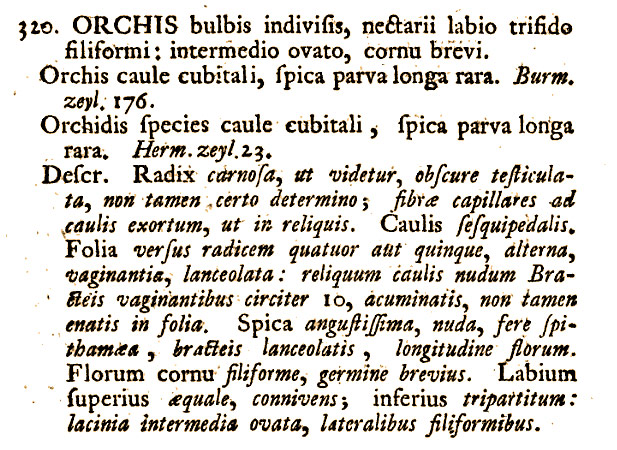
With beginning of the new year, the international botanical community has dismissed two requirements in describing new species or other taxa. It is now no longer necessary to include a Latin description of the plant, and the article describing a new species must not be printed, but can also be published online. “Beginning 1 January 2012 names of new plants, algae, and fungi may now be published with a validating diagnosis or description that is written in either Latin or English”, says an article which explains the decisions of an international botanical congress in July in Melbourne. The rules of introducing valid taxa are stated in International Code of Nomenclature for algae, fungi, and plants (ICN).
Richard Bateman on stability and change

Still looking for any hints to shed some light on the albiflora phenomenon, I visited Richard Bateman in London. The white-flowered morphs “are of greatest interest to me because of their relative frequencies in the diploid and the tetraploid groups of Dactylorhiza”, he told me. “If your mind works its ways through the different diploids – incarnata, fuchsii, sambucina – they all show colour polymorphism. And they all have a certain number of very pale or white individuals.” Quite different are the observations with tetraploid Dactylorhiza species like praetermissa, majalis or alpestris. Bateman noted: “I’ve only found one albino praetermissa and one albino traunsteinerioides in 30 years of going in the field.” Quite younger is the albiflora.eu project – but up to now only some scattered findings of white-flowered Dactylorhiza majalis have been reported – and none of praetermissa or traunsteineri. As a possible explanation Bateman noted: “Presumably, in the tetraploids there has to be a minimum of four copies of a gene that is malfunctioning to cause the albinism. So I think the tetraploids are buffered against albinism by having additional copies of the genes that generate the anthocyanin pigments.”
Arguing with him about the negative connotations of the term malfunction, Bateman answered: “Most organisms are ‘designed’ to remain the way they are and not to change [substantially]. So, from a genetic viewpoint, any change that is expressed is a malfunction. I agree the malfunction could be beneficial rather than negative but most times it’s negative.”
Bateman’s main interests in research are the questions of speciation or at least the question of what might lead to evolutionary divergence between populations: “The genus level – for me at least – is solved. The species level interests me the most now. That’s were the most challenging topics still have to be addressed – how orchids speciate.” Despite a huge literature on the topic, Bateman noted, those questions are still not adequately solved. “Each time I address a particular set of orchids, the answer [to this question] is different.” So up to now, no generalization is possible. But, Bateman said, “I strongly believe that the importance of pollinator [specificity] is being exaggerated by a lot of workers.”
At least one general observation can be stated according to Bateman: “New [evolutionary] strategies are tried out constantly – more than most people believe – but I think they succeed less often than most people believe.”
In addition to such reflections on stability and change in the genetics of orchids, we wondered why hypochrome forms of Ophrys are rather green than white – obviously the Ophrys flowers still contain chlorophyll even if they lack the anthocyanins – and with good reason: “The rosette leaves of Ophrys (and Himantoglossum as well) tend to be dead before the flowers properly open”, Bateman said. “So I don’t think there is much supply of nutrient coming from [root to flower]. The flower has become autonomous … whereas in Orchis or Anacamptis the flowers are far less independent.” So, Ophrys flowers are quite special. “One of the most striking things when you start working on the flowers, cutting them up looking at them under microscope, you realize how much energy is invested in an Ophrys flower. There is a lot of tissue.”
After the visit, the Royal Botanical Gardens in Kew have been the very right place to further contemplate on the miracles of nature. (With thanks to Richard Bateman for reviewing his quotes, additional notes are marked with brackets)
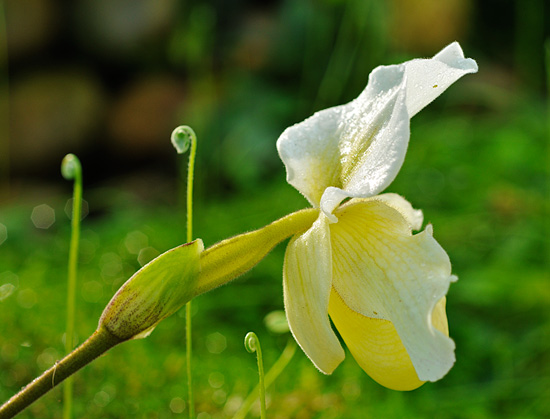
Colour AND form variety of Anacamptis morio
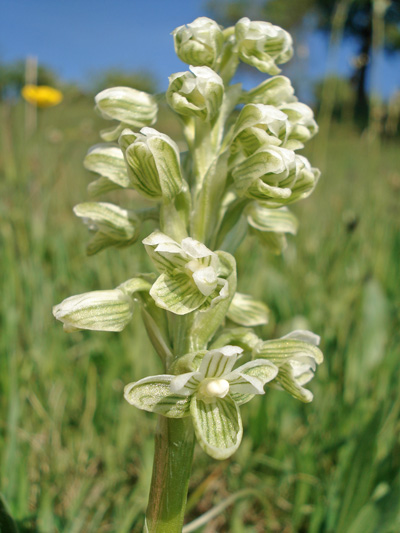
Oops, that’s a quite special Anacamptis morio which Norbert Griebl has found near Sittendorf, southwest of Vienna. In addition to the absence of anthocyanins (which happens quite often with this species) the lip has the same form as the sepals, with green veins. Here, not only the colour of the flower has changed, but also its morphological pattern.
